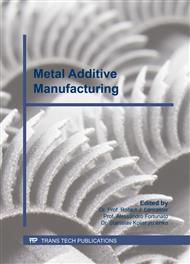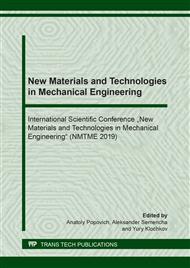[1]
Brøtan, Vegard, Olav Åsebø Berg, and Knut Sørby. Additive manufacturing for enhanced performance of molds., Procedia CIRP 54 (2016): 186-190.
DOI: 10.1016/j.procir.2016.05.074
Google Scholar
[2]
Anatoliy Popovich and Vadim Sufiiarov (2016). Metal Powder Additive Manufacturing,, New Trends in 3D Printing, Chapter 10, InTech,.
DOI: 10.5772/63337
Google Scholar
[3]
Mazur, Maciej, et al. Numerical and experimental evaluation of a conformally cooled H13 steel injection mould manufactured with selective laser melting., The International Journal of Advanced Manufacturing Technology 93.1-4 (2017): 881-900.
DOI: 10.1007/s00170-017-0426-7
Google Scholar
[4]
Horn, Timothy J., and Ola LA Harrysson. Overview of current additive manufacturing technologies and selected applications., Science progress 95.3 (2012): 255-282.
DOI: 10.3184/003685012x13420984463047
Google Scholar
[5]
Ackermann, Michal, et al. Impact Testing of H13 Tool Steel Processed with Use of Selective Laser Melting Technology., Materials Science Forum. Vol. 919. Trans Tech Publications, (2018).
DOI: 10.4028/www.scientific.net/msf.919.43
Google Scholar
[6]
Yan, J. J., et al. Selective laser melting of H13: microstructure and residual stress., Journal of Materials Science 52.20 (2017): 12476-12485.
DOI: 10.1007/s10853-017-1380-3
Google Scholar
[7]
Popovich, A. et al. Study of microstructure and properties of 316L steel after selective laser melting, METAL 2016 - 25th Anniversary International Conference on Metallurgy and Materials, Conference Proceedings (2016), pp.659-663.
Google Scholar
[8]
Choe, Jungho, et al. Densifying method in additive manufacturing process of H13 tool steel: laser re-melting., (2018).
Google Scholar
[9]
Cherry, J. A., et al. Investigation into the effect of process parameters on microstructural and physical properties of 316L stainless steel parts by selective laser melting., The International Journal of Advanced Manufacturing Technology 76.5-8 (2015): 869-879.
DOI: 10.1007/s00170-014-6297-2
Google Scholar
[10]
Sun, Zhongji, et al. Selective laser melting of stainless steel 316L with low porosity and high build rates., Materials & Design 104 (2016): 197-204.
DOI: 10.1016/j.matdes.2016.05.035
Google Scholar
[11]
Wang, Mei, et al. High-Temperature Properties and Microstructural Stability of the AISI H13 Hot-Work Tool Steel Processed by Selective Laser Melting., Metallurgical and Materials Transactions B (2018): 1-12.
DOI: 10.1007/s11663-018-1442-1
Google Scholar
[12]
Riemer, A., et al. On the fatigue crack growth behavior in 316L stainless steel manufactured by selective laser melting., Engineering Fracture Mechanics 120 (2014): 15-25.
DOI: 10.1016/j.engfracmech.2014.03.008
Google Scholar
[13]
Mertens, Anne, et al. Microstructures and mechanical properties of stainless steel AISI 316L processed by selective laser melting., Mater. Sci. Forum. Vol. 783. No. 786. (2014).
DOI: 10.4028/www.scientific.net/msf.783-786.898
Google Scholar
[14]
Wang, Di, et al. Investigation of crystal growth mechanism during selective laser melting and mechanical property characterization of 316L stainless steel parts., Materials & Design 100 (2016): 291-299.
DOI: 10.1016/j.matdes.2016.03.111
Google Scholar
[15]
Popovich, A. A., et al. Anisotropy of mechanical properties of products manufactured using selective laser melting of powdered materials,, Russian Journal of Non-Ferrous Metals (2017), 58(4), pp.389-395.
DOI: 10.3103/s1067821217040149
Google Scholar
[16]
Sufiyarov, V.Sh., Borisov, E.V., Polozov, I.A., Masailo, D.V. Control of structure formation in selective laser melting process,, Tsvetnye Metally (2018), 7, pp.68-74.
DOI: 10.17580/tsm.2018.07.11
Google Scholar
[17]
Sufiiarov, V. Sh, et al. The effect of layer thickness at selective laser melting,, Procedia engineering (2017), 174: 126-134.
DOI: 10.1016/j.proeng.2017.01.179
Google Scholar
[18]
Sufiiarov, V. Sh, et al. Selective laser melting of titanium alloy and manufacturing of gas-turbine engine part blanks., Tsvetnye Metally (2015), 8: 76-80.
Google Scholar
[19]
Popovich, A. A., et al. Use of additive techniques for preparing individual components of titanium alloy joint endoprostheses., Biomedical Engineering (2016), 50(3): 202-205.
DOI: 10.1007/s10527-016-9619-x
Google Scholar
[20]
Golod, V. M., and V. Sh Sufiiarov. The evolution of structural and chemical heterogeneity during rapid solidification at gas atomization., IOP Conference Series: Materials Science and Engineering, 2017, Vol. 192. No. 1. IOP Publishing.
DOI: 10.1088/1757-899x/192/1/012009
Google Scholar



